Visiting Grandkids in Texas - Part 2
/A tour of the Texas State Capitol in Austin with my grandkids.
Read MoreJuly, 2023: I have switched to writing most of my blog posts on my original WordPress blog so access all the current news there and sign up on that site for email updates.
A tour of the Texas State Capitol in Austin with my grandkids.
Read MoreVisiting the Science Mill in Johnson City, Texas on a recent trip to see my grandkids.
Read MorePhotos and commentary about two fiber shows in February.
Read MoreThe second part of the Shearing Day post.
Read MoreShearing Day on January 29, 2023. This post is Part 1.
Read MoreA close up look at the Jacob fleeces that we’ll be shearing next weekend.
Read MoreSome photos of ewes in full fleece before we shear in two weeks.
Read MorePhotos of the farm after days of winter rain.
Read MoreIt is rather last minute to still be working on things for Christmas sales, but I will be driving by the Artery today and have time to drop off a few more items.
A walk Across the Road inspired these last ecoprint scarves. I refer to them as Solano Garden Botanical Prints. Every time I do one of these I consider it an experiment. There are so many variables. Which part of the plant? Fresh or dry? Growing or dormant season? Front or back side of the leaf facing the iron or tannin soaked scarf?

This is the collection I brought home. Top left is an osage orange fruit (not edible) and some twigs. Next are black walnut leaves ready to fall off the tree. Third from left, top row, are a couple of sunflower seedlings that grew after the rain that germinated the leftover sunflower seeds at the edge of the field. Eucalyptus twigs and leaves are on the right. Just left of the eucalyptus is mistletoe. Bottom center is a pisolithus, a fungus known as dog turd fungus, that was emerging from the hard-packed dirt road. I’ll save that for a later dye-bath. There are also some oak galls and a couple of oranges.

Experiments 1 and 2. The scarves on the plastic were dipped in tannin. The lower one is spread with sunflower leaves and black walnut leaves. The upper one has eucalyptus leaves and a few sprigs of mistletoe leaves and berries. After spreading out the plant material I cover the first scarf with another that has been dipped in iron, roll these up and steam them.

Experiments 3 and 4. I started to cover these with the second scarves before I remembered to take a photo. So the one at the lower edge of the table is mostly covered. It has redwood, sheoak, and eucalyptus from our property. The upper scarf is the biggest experiment. I wanted to see what would happen if I slice the osage orange fruit. Osage orange is a popular dye plant, but it is the shavings from the wood that have dye properties. I have never heard of using the fruit. When you slice it is kind of squishy with a milky sap. Hmmm. I went ahead anyway. I tried to cut small slivers of the wood as well and sprinkled those on. Then I added eucalytptus leaves.

These are the two scarves that imprinted with sunflower leaves and black walnut leaves. In each pair of scarves I find it interesting to see how the leaves react on the tannin or iron soaked surfaces.
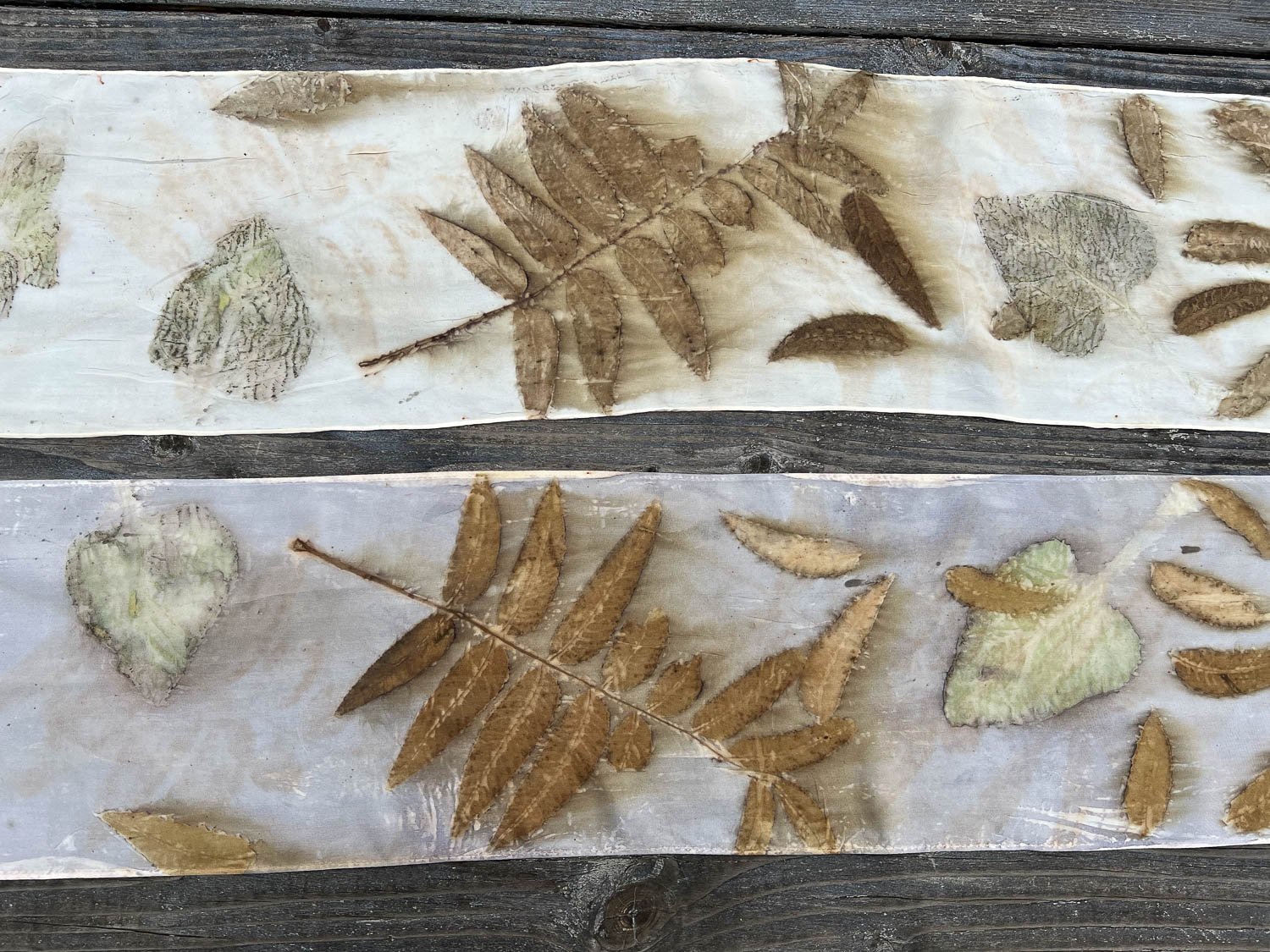
These are the same scarves, but a close up of a different part.
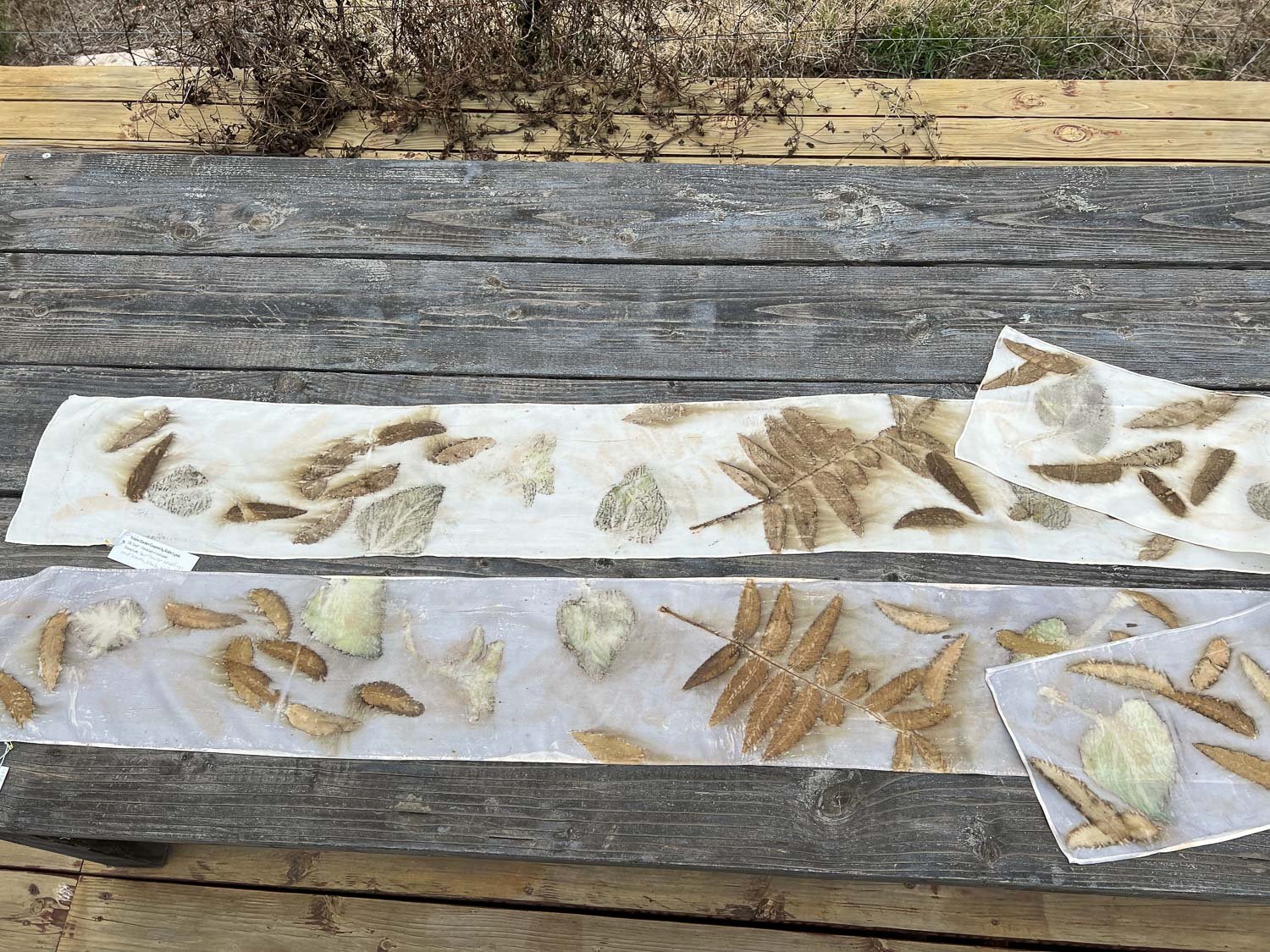
This is how those two scarves look.

These are the scarves with eucalyptus and mistletoe. The tannin soaked scarf shows something of the mistletoe—that’s the smudgy part, but there is very little on the iron soaked scarf. It’s interesting how the eucalyptus looks so different on the two.

Here’s the crazy one. Those circles are the osage orange fruit. The cut up twigs didn’t do much—there are some spots that you see on the upper scarf.

This is eucalyptus leaves (different from the ones Across the Road), redwood, and sheoak.
I’ll be delivering some of these to the Artery soon.
Sheep coats need changing periodically. These photos show before and after changing coats and how the fleece looks underneath the coat.
Read MoreI had too many photos for one blog post so I turned this story into two. The first is here.

On Sunday we set the alarm for 4:15 a.m. and drove to the venue where we could park and catch shuttle buses to the swim venue.

There were plenty of buses to get the athletes to the swim start and after the athletes all had seats the spectators could get on. We got to Lake Cahuilla by about 5:30 and the race wouldn’t start until 7. So there was a lot of time spent standing around in the cold and the dark and waiting. The athletes collected their decontaminated wetsuits and eventually found their places in the line of swimmers based on their anticipated finish times.

Here is a view of the rows and rows of bikes.

Meryl and Chris before the start of the race.

The pro-athletes went first starting at 7 a.m. The people in the water are the pros. All the others are self-positioning based on their projected times.

The non-pros entered the water in a “rolling start” about ten minutes later. I think they released 3 swimmers every 5 seconds…or was it 5 swimmers every 3 seconds? Something like that.

Dan and Meryl and I had to be patient, waiting for Chris to get to the start. Even though it was light by now it was still very cold. The sun was behind clouds for a couple of hours.

The cold was a concern for the athletes. This is a shallow lake and the water temperature fluctuates a lot with air temperature. The lake temperature was about 57 degrees.

I took this after all of the swimmers had entered the water. They swam on the left side of the yellow cones, around the far red cones, to a cone that is out of the photo to the right.

After passing around the far cone, they swam back to the finish and got out of the water.

There was a slight run to where the bags were hanging and then to the bike.

At the start of the bike portion there was a sharp left turn that went up a hill. Some chose to walk/run through that area while others struggled, especially if they started out in the wrong gear to climb the hill. This was the last place we saw Chris until the end of the bike portion.

All of us spectators had to wait to get on the buses until after 9. There had to be time for the last swimmer to exit the water, get on the bike and ride beyond the narrow road where the buses would exit.

The buses took us back to the Tennis Club grounds where everything else was staged. We only saw Chris as he finished the bike portion and ran into the bike/run transition zone.

This is close to half way on the 13.1 mile run. The athletes ran this loop twice.

This is just to give a view of the landscape. The runners are in the middle of the photo running next to the lawn. The hills and sky made a beautiful setting.

This is the second time past this point. Chris reported feeling pretty hot. That’s not surprising now that he lives in Idaho and the current highs are in the 20s or 30s. At this point we had to scurry to get inside the tennis club grounds so we could be at the end when Chris got there.

I don’t have a good photo of the finish, but Chris looks good here.

And Chris and Meryl both look great here at the end. Nice medal, Chris! And we’re proud of you.
By the way, one of the things the athletes were given in the gear bags was a white plastic wrist band. They were told to honor a volunteer by giving it to the person who helped the most. The next day on the way home, after dropping Chris and Meryl at the airport, I looked for something in the center console of the car and found the wristband and a note from Chris. He said that we earned the wristband for the support we have given him over these last years. Isn’t that touching?
We spent a weekend away from the farm to hang out with Chris and Meryl at the Ironman 70.3 held in Indian Wells, near Palm Springs. They both signed up to do this event long ago but what with a move to Idaho and Life Complications they deferred to this year. Meryl is injured and didn’t compete but we all went to support Chris. Meryl flew to Palm Springs on Saturday morning and we picked her up before heading to the Ironman venue.

This is a view of the entry to the Ironman Village. This staging area was at a huge tennis pavillion and is the location of the bike/run transition and the finish. The planning and infrastructure that is part of the Ironman event is astounding. As you look through these photos imagine all the work that happens behind the scenes prior to this event and all of the equipment needed to set up the venues. I wrote about the Sacramento Ironman in October here and mentioned some of the issues. They have held this event at Indian Wells for a few years now and they have eliminated all the pitfalls.
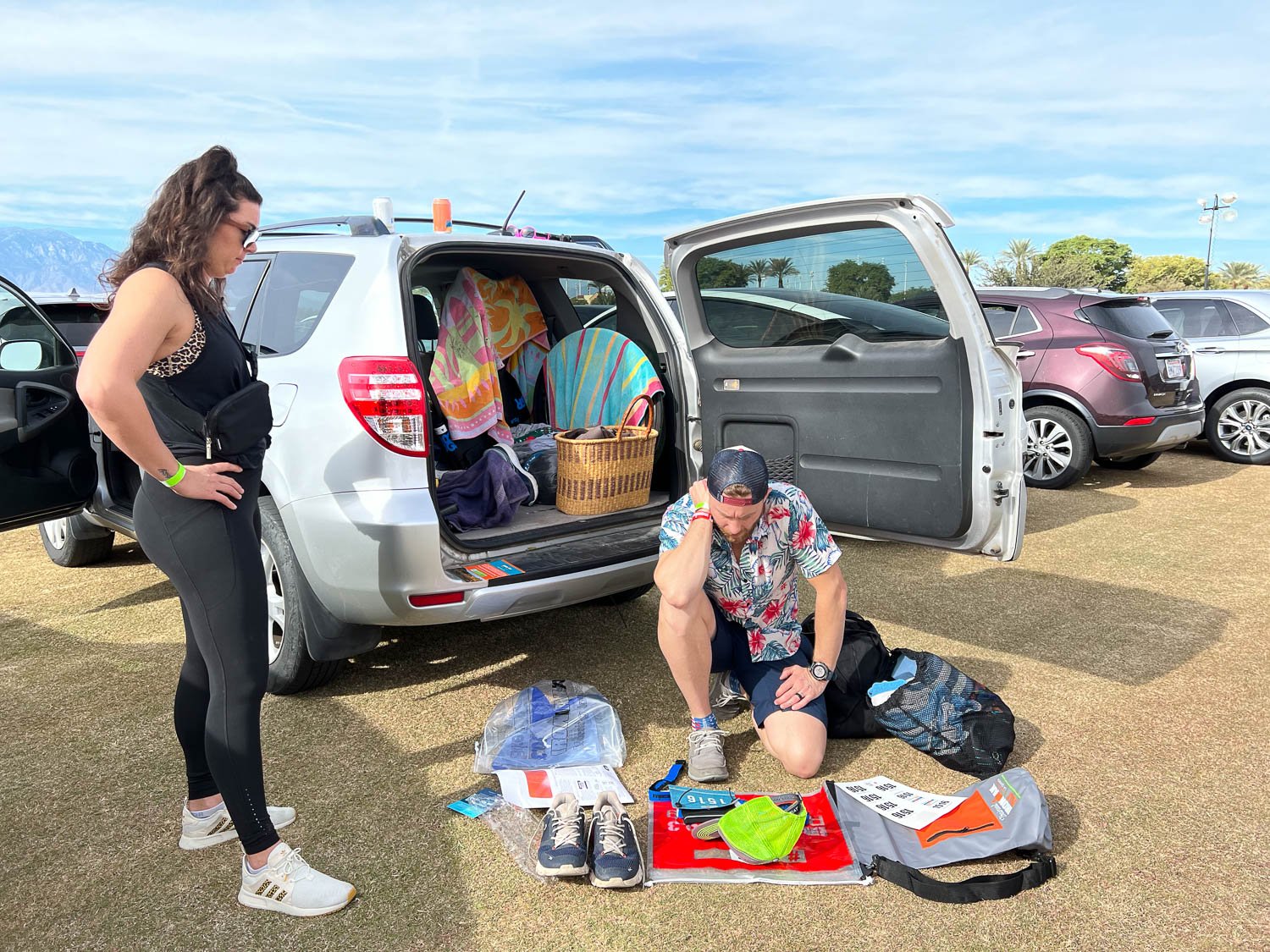
Chris picked up the transition bags and a page of stickers with his number. The order of events is always Swim, Bike, Run. and the athletes try to get through the transitions as smoothly and quickly as they can—it’s all part of the accumulated time. In the Swim/Bike transition they have to strip off the wetsuit and pick up the helmet and cycling shoes and any other clothing or gear needed for the bike. They may change into other shorts or wear what they were wearing under the wetsuit, but maybe add sleeves or legs for cold weather. There are gear bags to hold the next outfit and to stash what is being left behind. Chris has experience with this so has it pretty well planned out, but it is important to get everything right. Each bag has the athlete number. There were over 1800 participants—that’s a lot of bags if they get mixed up.

An unusual addition for this event was the decontamination of the wetsuits. This was to prevent introduction of the quagga mussel into the lake.

Wetsuits were held in chlorinated water for 15 seconds and then hung to dry. Each athlete was given a tag to attach to the wetsuit to show it had been dunked. On race-day morning no one without that tag was to be allowed in the water.

The next step was to leave the bike and gear bag, all properly numbered, at the racks set up in the swim-bike transition area.

Before we left the lake for the day I noticed this sign.
We went back to the hotel and, wanting to give Meryl and Chris a chance to relax (and me not wanting to watch football for 4 hours), Dan and I went off in search of something to explore.

We drove not far out of town to the Visitor Center for the Santa Rosa and San Jacinto Mountains National Monument. This bighorn ram stands guard outside. The visitor center and the gates were closing in about 20 minutes so we did a brief walk along a nature trail nearby and then drove to a parking area where we could access another trail.

The main road was far off but I was able to zoom in on this sign.

We stopped at a 2.5 mile trail that makes a loop through the desert terrain.

Starting out on the trail.

This is looking back towards the Visitor Center and the San Jacinto Mountains.


There are several varieties of cactus out here.

It was getting to be dusk by the time we were ending the hike.

We were able to enjoy a beautiful sunset over the distant mountains.
Most Jacob sheep are black and white, but those with spots that are grayish-brown or brownish-gray are called Lilac. It is often difficult to tell a lilac sheep from a black and white sheep simply by looking at the sheep in full fleece. Even spots that are truly black may appear brown because the tips are sunbleached, but underneath the fleece is black. This is one reason that even the blackest Jacob yarn may have a brownish cast. Look at the facial markings to tell the true color.

These two rams are a good example of the difference between lilac and black. That is Meridian Silverado on the left and Patchwork Townes on the right. The color difference between these two is obvious, however sometimes it’s hard to tell if you’re looking at black markings or something that is lilac, but on the dark side.

This is a ewe named Lupine. She looks dark in this photo but she is lilac. Her dam and grandsire on her sire’s side are both lilac.
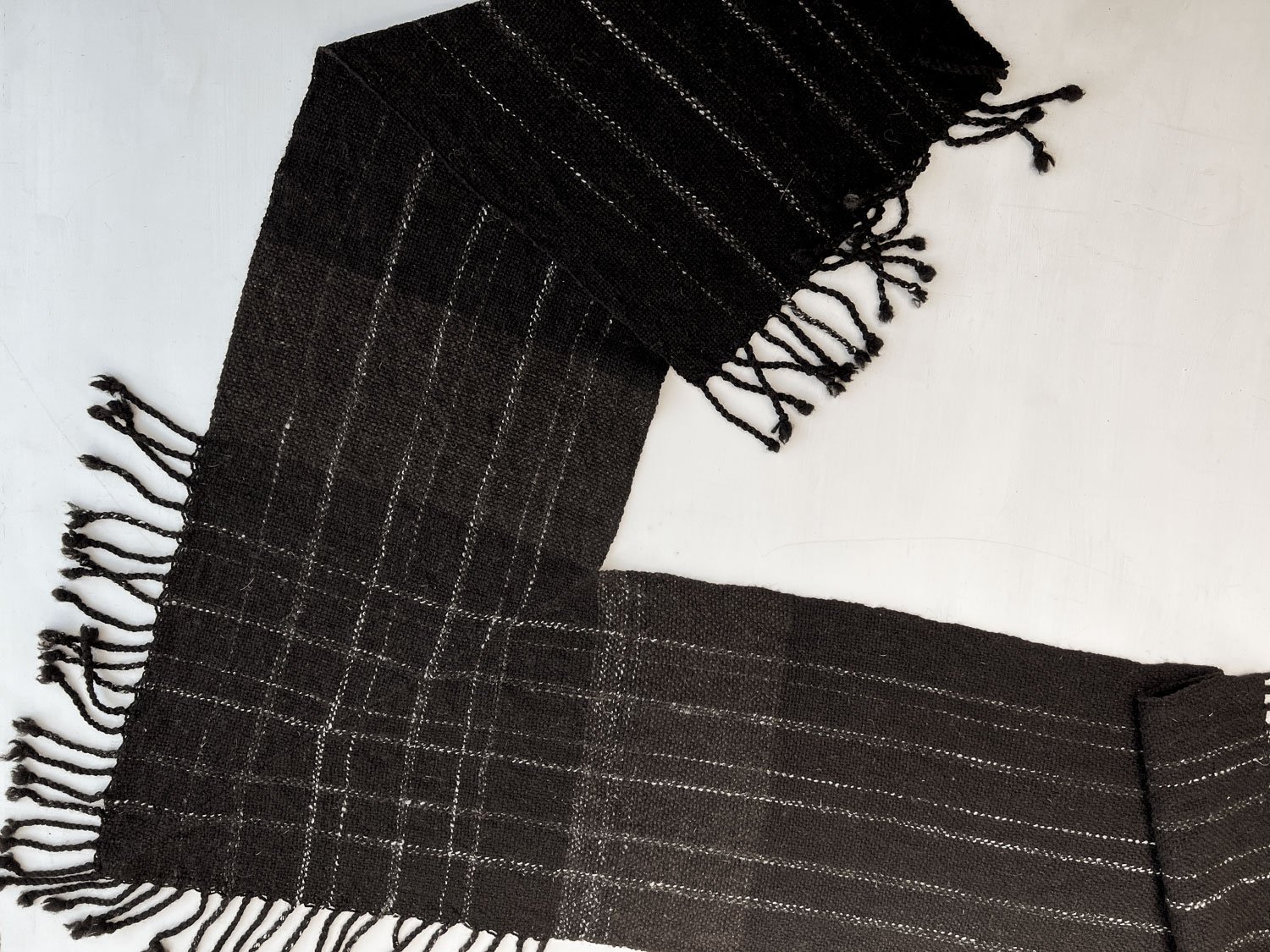
This is a handspun shawl I wove last summer using wool from Beauty, a black and white sheep. As I was weaving I knew that I’d run out of the black wool, so I spun some of Lupine’s wool to fill in. That is the gray part before the v of the shawl. (This shawl is for sale here.)
The original intent of this post was to show several ewes that I sometimes get mixed up—they are two horn lilac ewes and I think they all look similar.

This ewe is Meridian Foxy.

Meridian Vixen.

Meridian Lavender. Vixen’s and Lavender’s ear tags (ID tags in the left ear) are 6046 and 7046 so that is another way to get them mixed up.

Meridian Belle.
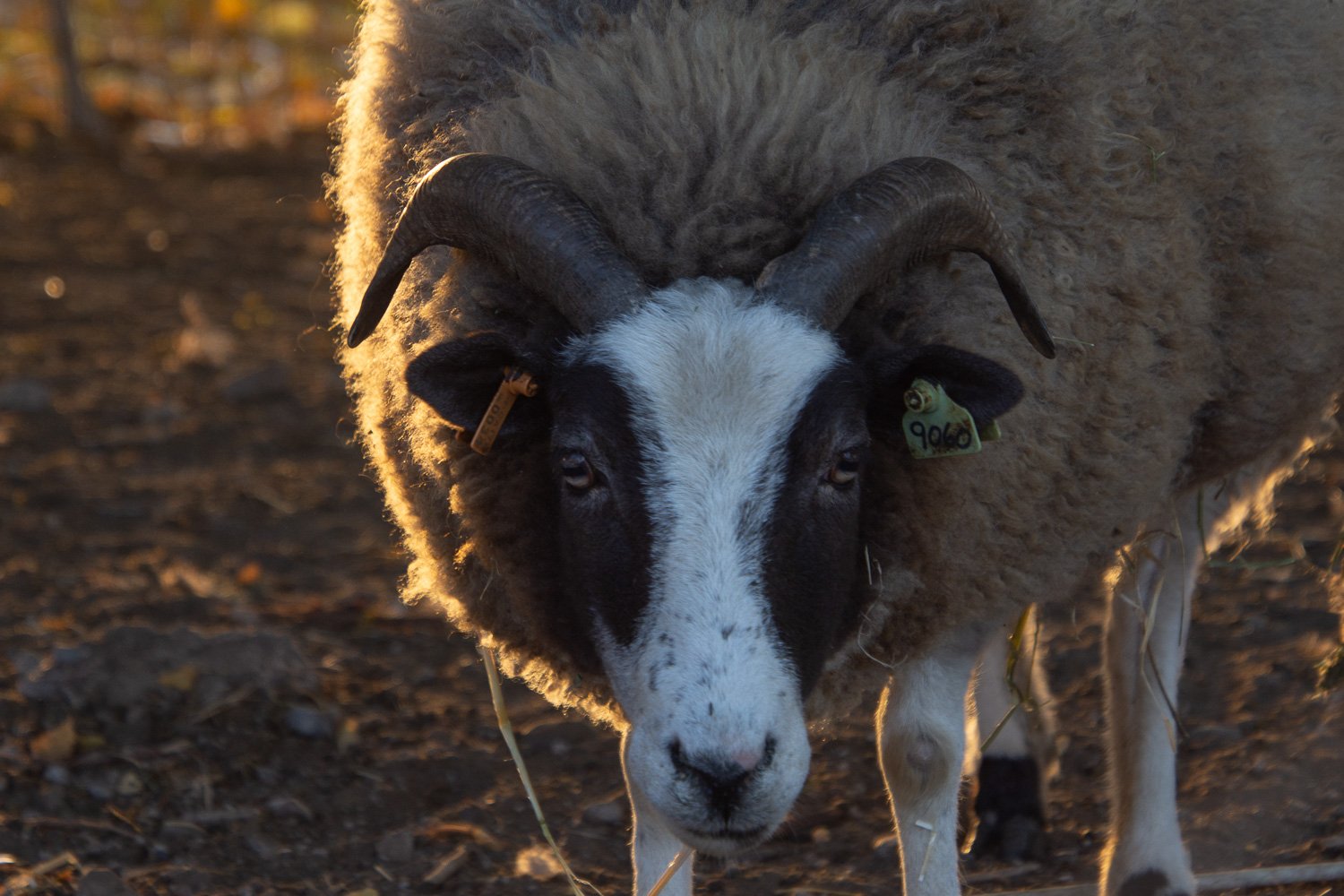
Meridian Bessie. Belle’s and Bessie’s numbers are 9006 and 9060, another reason to lose track.

The other ewes were all bred and born here. This is Patchwork Amara from Georgia.
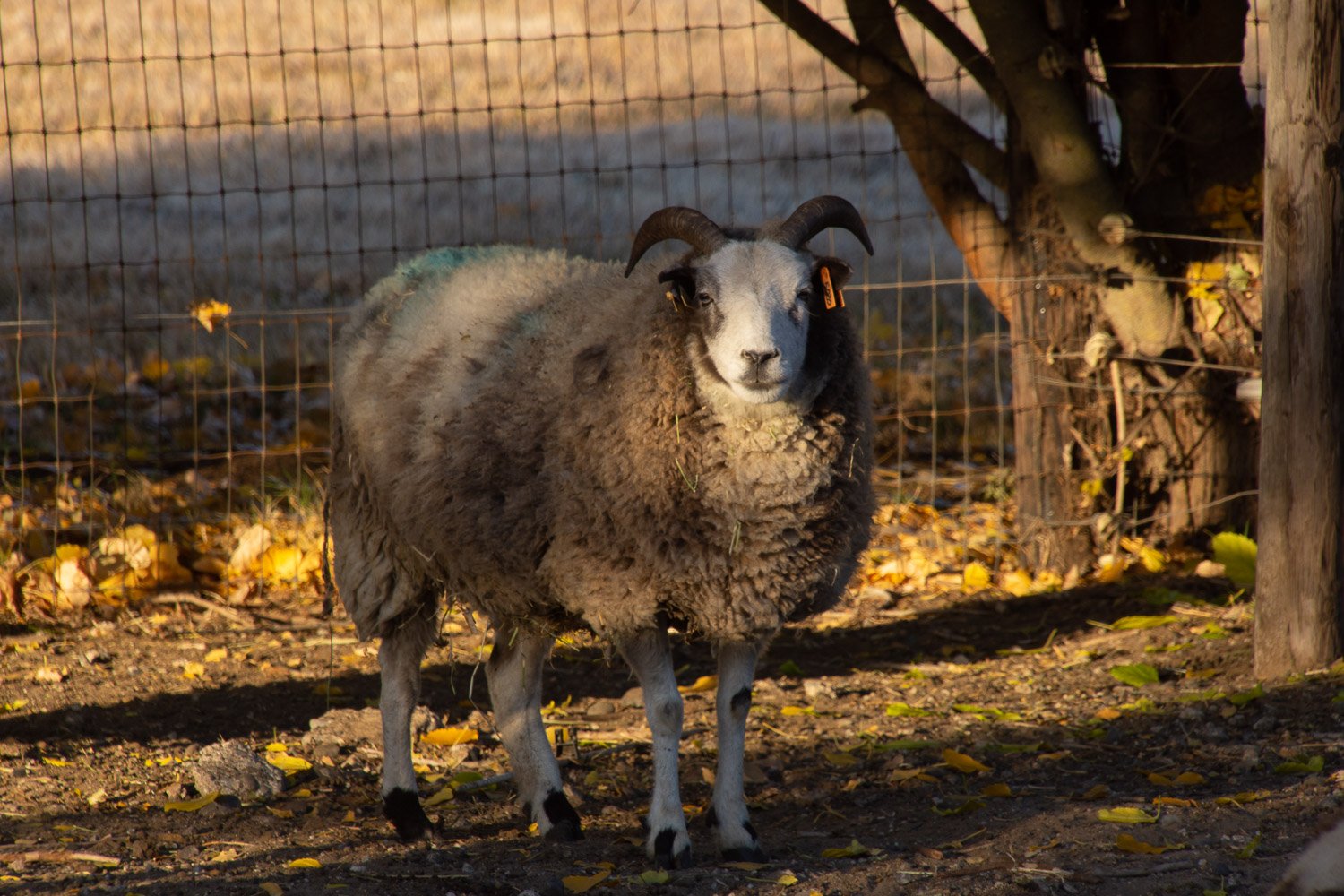
These are full body photos of the ewes above. This one is Foxy.

Vixen.

Lavender.

Belle.

Bessie.
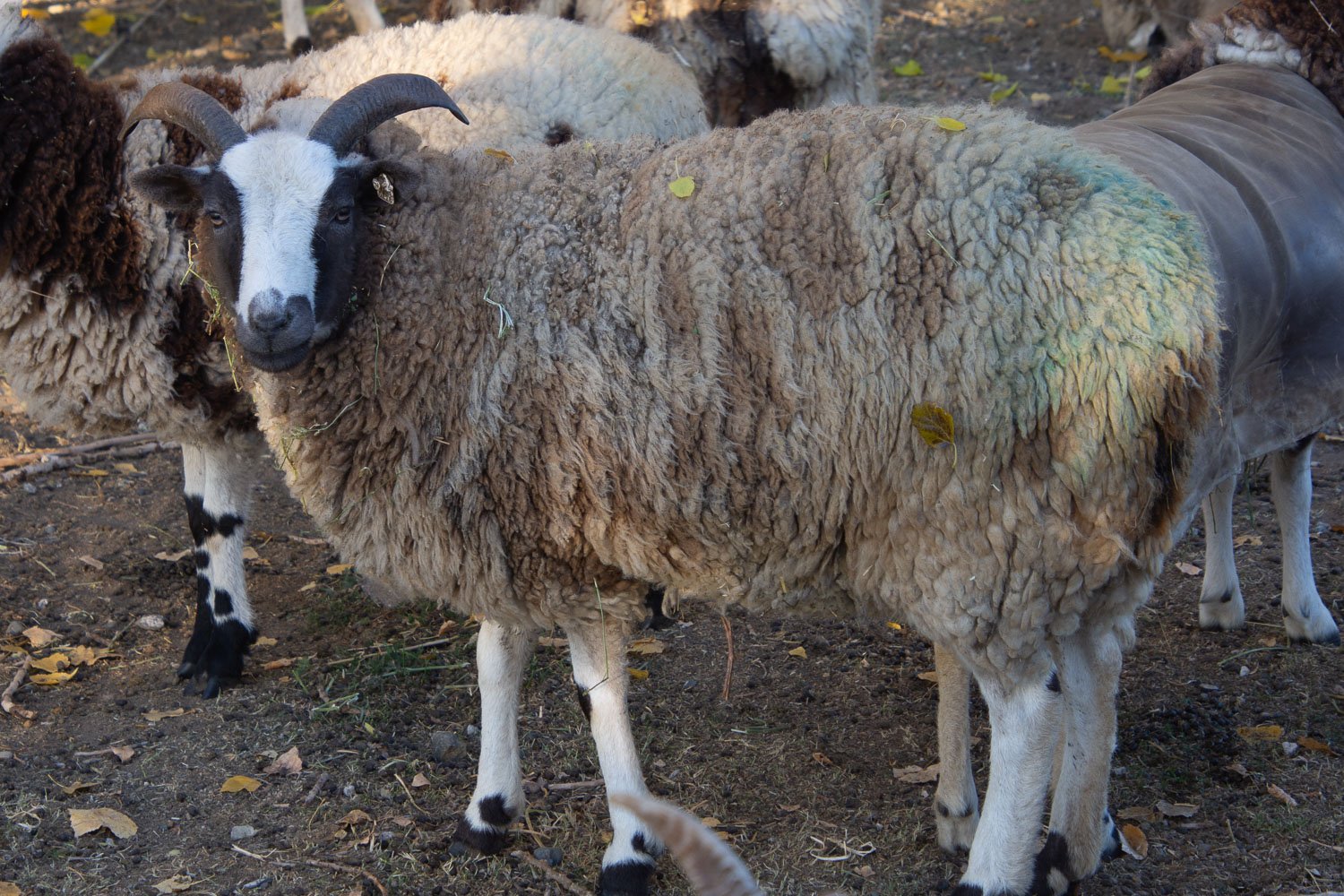
Amara.
Can you tell why I get these mixed up?

I won’t mix up these sheep, but they point out more of the variety of lilac coloring. From left to right this is Axis, Thorn, and Bravo. Axis is a yearling and the other two are March 2022 lambs. Thorn is a black and white ram, although his wool looks very dark brown in this photo—remember, that is because the tips are sunbleached. Axis and Bravo are both lilac rams but there is a big difference in the look of the wool.

Axis has the gray wool typical of my lilac Jacob ewes. Bravo’s wool is a bit browner. This photo makes him look a light brown, but that is those sunbleached tips again. Wait for shearing day for some interesting photos of the fleeces.
I needed to find some photos for a special request. You’d think that with over 4300 sheep photos (according to Lightroom) I wouldn’t have to take more. But I did. I’ll share some. Most are in the Sheep Portrait category.

Meridian Hazel, one of our very friendly sheep. She will be three when she lambs in the spring.

Meridian Raquel is our second oldest ewe. She will be 10 in the spring. Her upper right horn was damaged and grew down over her face. For years it was right in front of her eye but it broke a few years ago and now she has full vision.

Meridian Janna, almost five years old.

Hillside Hannah’s Grace came from Michigan in 2021. She will lamb for the first time in the spring.
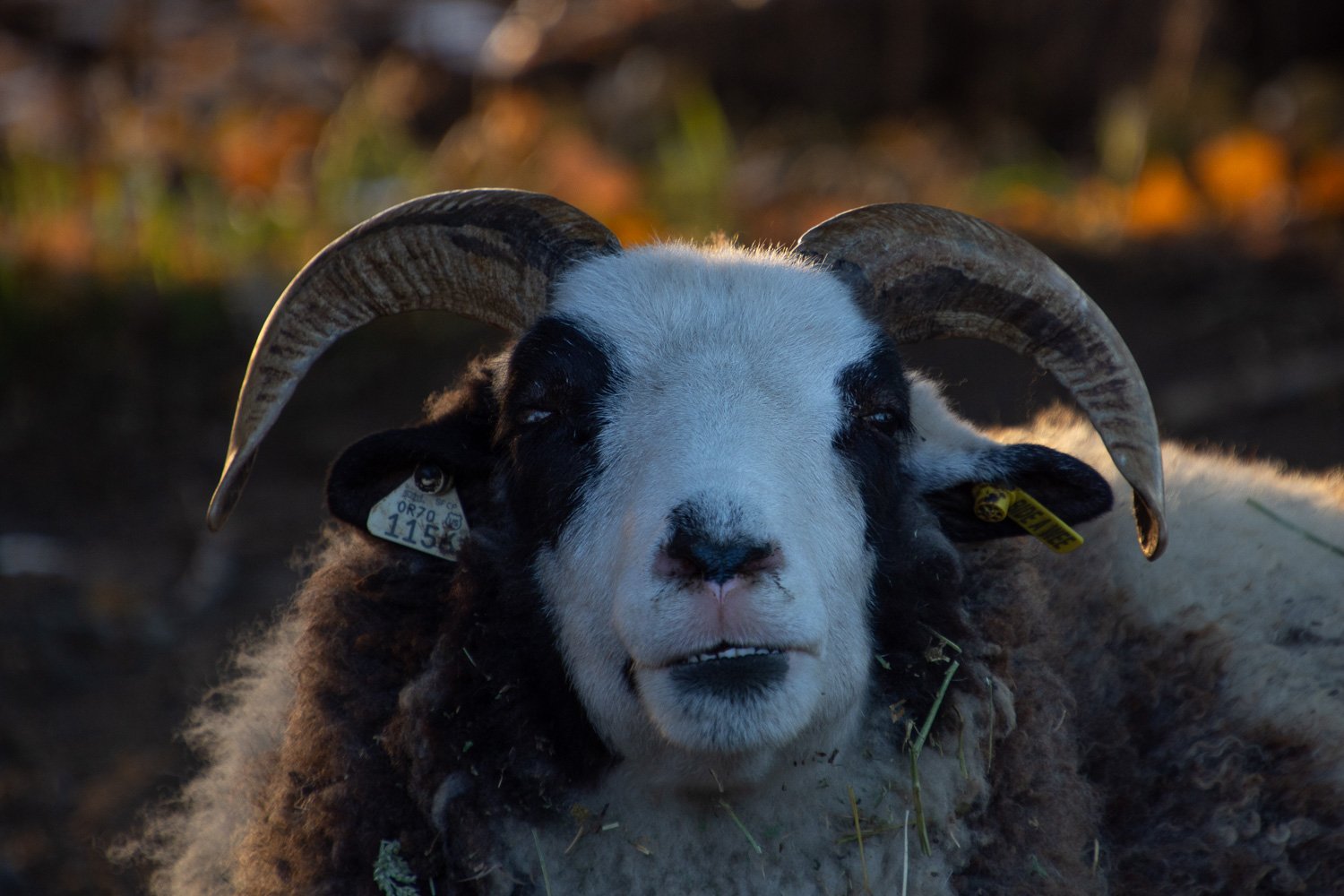
This ewe, bide a wee Hallie, came home with me from Black Sheep Gathering in Oregon 7 years ago.

Meridian Terri, a 5-year-old ewe.

Meridian Lenore, one of the 2022 lambs.

This is Lenore with her dam, 5-horn Sweetgrass Tranquility, a ewe who came from Michigan in 2021.

Another mother-daughter pair. The daughter is Meridian April, the last lamb born in 2022, and her 4-horn dam, Meridian Columbine.

The sheep are still spending a lot of time in the pasture, but they come in as a group to relax. After an hour or so they will get up and go back out.
I taught a short weaving workshop today as part of Sacramento Weavers’ Mini-Workshop meeting. The topic was Clasped Warp and all seven participants finished warping their rigid heddle looms. The time didn’t allow for weaving, but the goal of the workshop was to teach this warping technique, and everyone knew that they’d have to do the weaving later at home.
This blog post is going to serve as a follow-up to the workshop after I fielded a question from one of the participants about why the warp isn’t visible after she started weaving. The point of a clasped warp is that you will see that design in the finished piece. I can tell already that this blog post is going to be too long and I’ll do another with clasped warp photos. This post is about how different cloth looks on the loom and after wet finishing. And it is about Beat.

Blue and white fabric on the loom. Each of the bands of color is 8 threads and you can see that the bands are just under an inch. That means the weft was “beat” at 8 picks per inch (8 ppi).

After washing those bands are closer to 3/4” and the weft picks are more like 10 ppi. That is because the yarns are no longer under the tension that they were on the loom and they have relaxed. Wet finishing (soaking in water) helps the yarns to bloom and also lessons some of the space between yarns.
We talk about “beating” the weft and we use the “beater” that is part of the loom. One of the definitions of beat in Webster's Dictionary is “to strike directly against forcefully and repeatedly”. In terms of weaving that might work well if I was making a saddle blanket or a rug or another dense fabric. But if I want my fabric to have the drape of a scarf or shawl, especially when using a stretchy wool, then maybe I should “nudge” the weft pick. Webster’s definition of “nudge”: “To touch or push gently”.

Its difficult for beginning weavers to realize how lightly one can beat (nudge) the weft yarn and have a successful project. However, each yarn is different and what works for one may not work for another. That’s why sampling is a good thing when you start with an unknown yarn. The lower sample above is woven with the local Timm Ranch wool yarn sett at 8 epi (ends/inch).
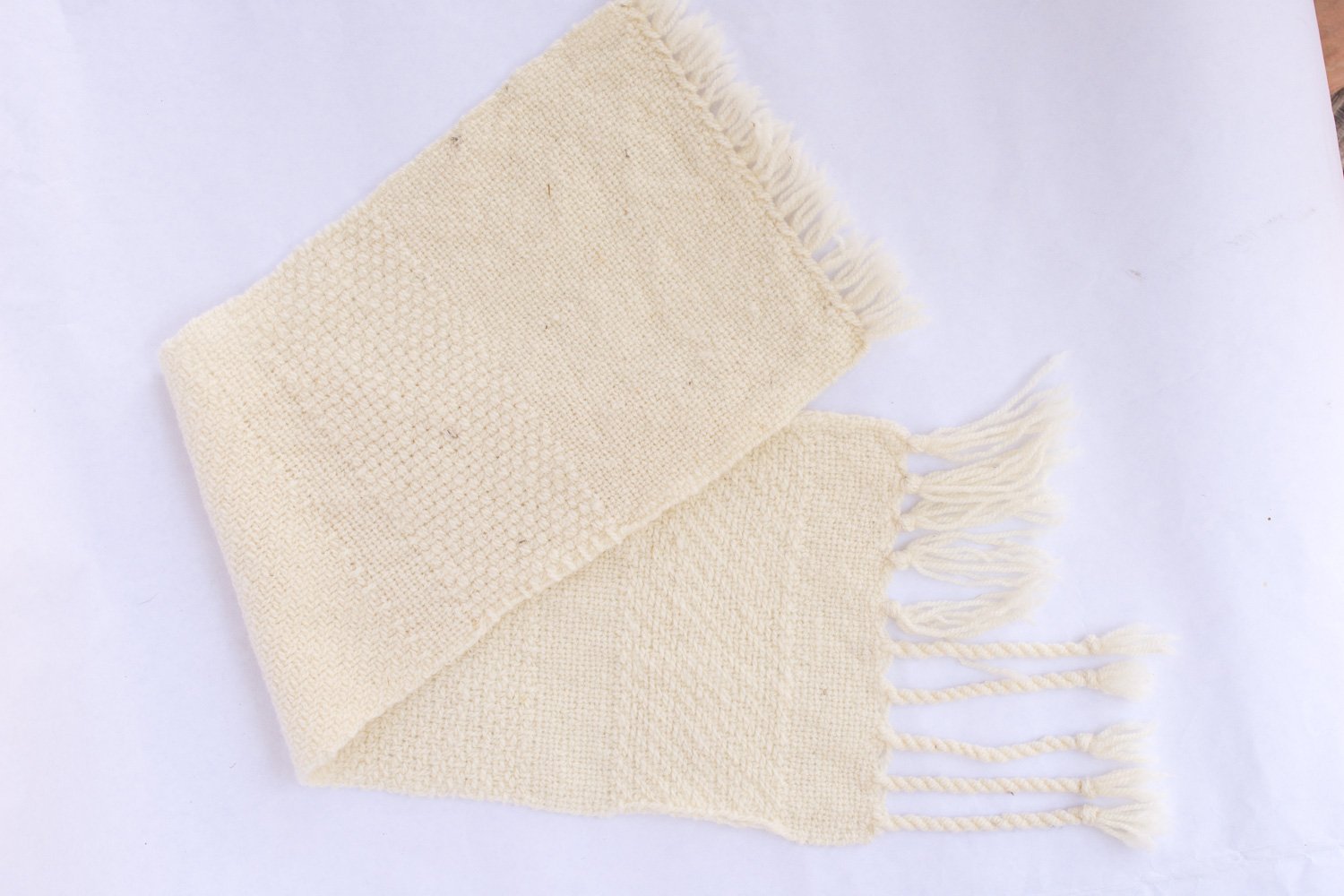
This is how it looks after wet finishing. I have worked with this yarn extensively and know to expect this outcome. So I sett the yarn appropriately.

This shows the difference in the yarn before and after wetting. The fiber doesn’t shrink, but the yarn relaxes and “blooms”. This is important to know when planning a project.

This shows the yarn in skeins. The one on the right has been soaked in water and allowed to dry naturally. This is off the topic of “beat” or “nudge” but it all affects the outcome of the project.

This warp is a mix of Jacob yarn and Timm Ranch yarn dyed with black walnut and mushrooms. It is sett at 6 epi. Notice how it looks loosely woven.

The warp was long enough for several shawls. The photo shows an unfinished and a finished piece. I wet finish large pieces in my old top loading washing machine. I put the fabric in hot water and detergent, agitate for usually 2 to 3 minutes, and then spin out the water. I remove the fabric to fill the washing machine with rinse water and then soak the piece briefly without agitating. I use the spin cycle to remove the water.
Here are a few more before and after examples of pieces I recently wove for my Shades of Black and White show at The Artery.

This is Jacob yarn sett at 8 epi. It’s important to nudge those yarns at 8 ppi to maintain the balance of the squares. If I beat harder I’d lose that pattern.

The finished scarf.

Close up of the pinwheel fabric.

This is another shawl using Jacob yarn. It was sett at 8 epi. Beat is 8 ppi.

This is after wet finishing (3 minutes of agitation). The fabric is thicker because the yarns have bloomed. It has a lot of drape and bounce. My notes show that draw-in (widthwise) and take-up (lengthwise) and shrinkage was 22%. So this started out at 25” wide on the loom and finished at 19.5”.

Here is another using Jacob wool. The details are similar to the previous one—8 epi and 25” wide on the loom. This design relies on alternating two dark threads and two light threads in warp and weft.

The shawl is 19” wide after finishing. This pattern behaved differently with 25% change widthwise and 18” lengthwise.
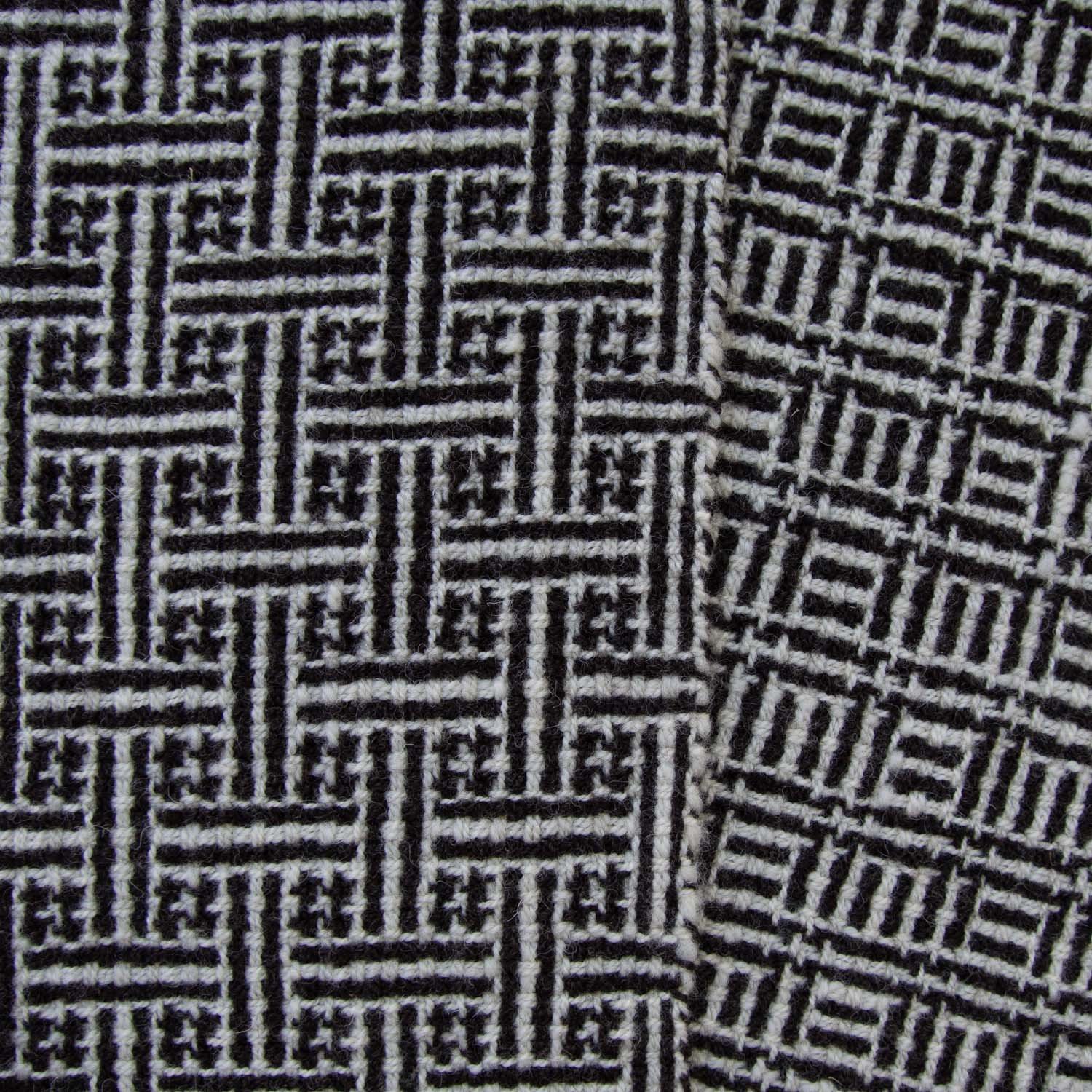
Here is a close-up of the fabric. I love the difference in the two sides of the fabric.

This is the last piece that I wove for the show. It uses the clasped warp technique, but on the floor loom instead of a rigid heddle.

I forgot to get a photo of this one before I set up the show so I took a quick shot at the Artery.
My brother called me last week and said he was hiking just north of Fairfield. He asked if I wanted to go hiking the next day. These are some photos from that morning.

The hike is through the hills now covered with dry grass. Part of the landscape is oak woodland.

A dirt road traverses the property. There is plenty of signs that cattle graze this area for part of the year. We didn’t see any livestock now.

This is a view looking south. You can barely make out the wind turbines on the horizon.

We spent a lot of time near this tree trying to get photos of the ruby-crowned kinglet that was flitting around the branches.

It is a bird that doesn’t stay in any one spot long enough for a decent photo. My bird book says “Kinglets are active, nervous birds, constantly flicking their wings rapidly.” So it’s not just me and my photography skills.

I took more than a dozen photos of this one bird and ended up with these.

I don’t know how he did it, but my brother got this one.

That’s Mt. Diablo in the background and the Suisun Marsh in the middle. You can barely make out three dark shapes at the edge of the water just below the far-away hill on the far right of the photo.

This is a close-up view. The three dark shapes are large ships, part of the “mothball fleet”. in the Suisun Bay. Those are old ships that are no longer needed but were kept in reserve for years. This link discusses some of the environmental issues that resulted from letting these old ships deteriorate in place for so many years.

Another view from the hills. That’s Ginny and Dave’s dog, Daisy.

Looking southwest.

Everything is so dry now it was good to have a water tank that the dogs could reach.
My Mom was a veteran. I wish I could share more about her time served. We have photos and letters but haven’t taken on the project of organizing them to learn the story now that it’s too late to ask her. When I read the letters several years ago I got the feeling that she was a very different person at that time than the one I knew as Mom. That makes sense because she was 27 or so and became a mom at age 38. In the years that I have memories she was in her late 40’s and older and a much different person then.
This blog post is just meant to gather some of the photos that I scanned quite awhile ago and just found on my computer. My daughter and I have talked of putting Mom’s letters together in a book, transcribing the hand-written ones. I thought of this after seeing a Ken Burn’s show on World War II because of the way he followed the lives of people involved in the war. I think her letters provide a glimpse of the everyday person’s life at that time. I hope that one of us has time to follow through on that project someday.

The writing on this photo says “We prepare for inspection. April, 1943.”

“Relaxation after Saturday (?) inspection.”

I don’t have details on most of the photos. I know that she was in Palm Springs.

Here is one letter that I scanned. I have a binder (somewhere) with the others, or maybe my daughter has that now. I’m feeling like I want to follow through on this now. I found this link that explains the origin of the WAACs (Women’s Auxiliary Army Corp) in 1941 and the conversion to the WACs (Women’s Army Corp) in 1943.

I have no details on the rest of these photos.




Maybe there will be future posts if I ever find time to dig deeper into this.
It was still mild weather. The Sacramento Valley got rain, but not much here—not enough to show in the rain gauge.

The sheep moving to the gate where I will let them into the next paddock.

A sheep farmer’s version of fall color. Peyton, the BFL ram, was the one with the red marker. I moved his ewes out a few days ago and now they are with Townes. Silverado and Barrett still have some ewes, but I’m getting ready to be finished with breeding season.

This is one of my favorite views of the property.

Patchwork Townes is the ram with the most ewes now at the end of the season. His marker has been switched to green, but I think there is only one ewe marked green.

We held Hug a Sheep Day on Saturday, but it was mostly for Farm Club members with a few other friends who came. We had the most huggable sheep available. That’s Jade and her daughter, Hazel.

At the end of the day I walked across the road and took my customary photo looking south to Mt. Diablo. One of these days I’ll share the series of photos I took from this spot throughout the growing season.
At Meridian Jacobs farm we raise Jacob sheep and sell locally grown wool fiber, yarn, and handwoven goods. We teach fiber classes and sell Ashford, Clemes & Clemes, and Schacht spinning and weaving equipment. We encourage farm visits with field trips and our unique Farm Club.
Search blog posts since 2019. If the search says it can’t find a post try putting in your search word a second time. I don’t know why but the second time it seems to work.
Search the entire website, including older blog posts.